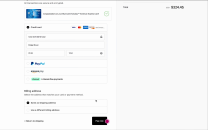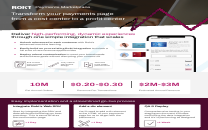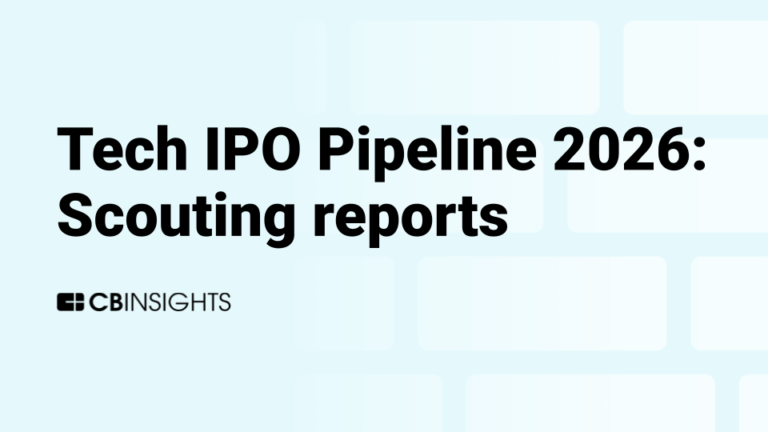
Rokt
Founded Year
2012Stage
Secondary Market - II | AliveTotal Raised
$488.5MValuation
$0000Last Raised
$335M | 10 mos agoRevenue
$0000Mosaic Score The Mosaic Score is an algorithm that measures the overall financial health and market potential of private companies.
-53 points in the past 30 days
About Rokt
Rokt focuses on electronic commerce technology. The company offers solutions to increase revenue, acquire customers at scale, and form relationships with existing customers. Its solutions include optimizing and monetizing the checkout experience, providing payment providers during checkout, and offering premium post-purchase offers. The company operates in the e-commerce sector. It was founded in 2012 and is based in New York, New York.
Loading...
Rokt's Product Videos


Rokt's Products & Differentiators
Rokt Ecommerce
Use advanced machine learning to offer each customer the most relevant messages, products, services and experiences, from cart to confirmation page.
Loading...
Research containing Rokt
Get data-driven expert analysis from the CB Insights Intelligence Unit.
CB Insights Intelligence Analysts have mentioned Rokt in 2 CB Insights research briefs, most recently on Nov 3, 2025.

Nov 3, 2025 report
Tech IPO Pipeline 2026: Book of Scouting ReportsExpert Collections containing Rokt
Expert Collections are analyst-curated lists that highlight the companies you need to know in the most important technology spaces.
Rokt is included in 5 Expert Collections, including Unicorns- Billion Dollar Startups.
Unicorns- Billion Dollar Startups
1,309 items
Ad Tech
4,236 items
Companies offering tech-enabled marketing and advertising services.
Targeted Marketing Tech
453 items
This Collection includes companies building technology that enables marketing teams to identify, reach, and engage with consumers seamlessly across channels.
Loyalty & Rewards Tech
178 items
Retail Media Networks
143 items
Rokt Patents
Rokt has filed 4 patents.
The 3 most popular patent topics include:
- commerce websites
- online auction websites
- payment service providers

Application Date | Grant Date | Title | Related Topics | Status |
|---|---|---|---|---|
3/18/2020 | 10/3/2023 | Payment systems, Social networking services, Online auction websites, Commerce websites, Payment service providers | Grant |
Application Date | 3/18/2020 |
|---|---|
Grant Date | 10/3/2023 |
Title | |
Related Topics | Payment systems, Social networking services, Online auction websites, Commerce websites, Payment service providers |
Status | Grant |
Latest Rokt News
Nov 11, 2025
Brands are moving fast on their AI rollouts in everything from marketing to design — meanwhile their employees are left guessing if these tools will empower or replace them. Even as more fashion companies tout their AI moves, publicly employees say internal guidance hasn’t kept pace. (Getty) By Key insights Fashion brands are loudly promoting their AI experiments — from digital models to virtual stylists — but staying quiet internally about what these moves mean for employees. Clear communication around how AI will be used, the potential impact on jobs and access to training or tools can reduce anxiety and boost employee engagement. Leaders who’ve been transparent about both the risks and the opportunities say they’ve seen stronger employee trust, adoption and performance as a result. Subscribe to the Daily Digest The essential round-up of fashion news, analysis, and breaking news alerts.Plus, access one complimentary BoF Professional article of your choice, each month. Subscribe Receive news, offers and invites from BoF Our newsletters may include 3rd-party advertising, by subscribing you agree to the Terms and Conditions & Privacy Policy . Fashion executives often say they want their employees to experiment with AI. They’re often met with suspicion; whether they work at corporate headquarters or in the warehouse, workers worry they’re being asked to train their own replacements . Lately, it’s looking like the sceptics might be onto something. Amazon, Target and UPS are among the companies that have announced layoffs — in some cases numbering in the thousands — while others have scaled back hiring. None explicitly cited AI in their announcements, though many reports noted these same companies have been touting AI investments to automate work and drive productivity. In September, Walmart chief executive Doug McMillon said the company planned to hold its global payroll steady at 2.1 million employees for the next three years, thanks in part to AI-driven efficiency gains. Even as more fashion companies tout their AI moves publicly — from AI-generated models at H&M to Zalando’s shopping assistants — employees say internal communications haven’t kept pace. Many find themselves navigating an awkward in-between: Some quietly use AI to speed up design iterations, line sheets and presentations but keep it hidden for fear of looking lazy. Others avoid it entirely, worried about unwittingly crossing a line — or making themselves obsolete. ADVERTISEMENT Mixed messages from the top aren’t helping. Leaders say they want AI put to use everywhere, and encourage workers to experiment with the technology. But they don’t always take the same comprehensive approach to training employees in how — and how not — to use it. Assurances about job security are maddeningly vague, often because even the CEO can’t say for certain that AI really will be a helper, not a replacement. Rather than inspiring top talent to innovate, these ambiguous, constantly shifting policies can drive them out. Experts say it’s time for fashion leaders to have the talk with their employees about AI — even if not everyone will like what they hear. Rokt, an e-commerce tech firm, took the direct approach. Earlier this year, chief executive Bruce Buchanan told his roughly 800 employees that up to 45 percent of their jobs would be “displaced” as the company adopts AI tools to move at “five times our speed.” Over the next few months, the company provided access to a range of AI tools that could help with everything from product design to writing an email, and hosted training sessions. Rokt also removed all regular internal meetings from employees’ calendars, instructing them to use the time to experiment with AI. “That was the objective — to normalise [AI],” said chief development and culture officer Simon Curran. “To [say], ‘We’re all in this together.’” But there was a second message the company wanted to convey. “You either change with us and we support you to do it, or it’s going to become awkward,” Curran said. ADVERTISEMENT There are any number of ways to deliver the message that AI is joining the team: A few months ago, Silver Jeans chief marketing officer Amy Pascal asked her 15-person team to stand along an imaginary line. “One end is, ‘I love change and innovation — I’m excited about the future.’ The other is, ‘The future, especially with technology, scares me. AI scares me,’” she recalled. As her team spread out along the line, Pascal placed herself firmly on the optimistic end. Still, she said, “I made room for everybody. It’s okay wherever you are — we’re going to go on this journey together.” Her message, she said, wasn’t a promise of job security but a challenge to rise to the occasion. “If we can do something faster, better, cheaper, I’m always going to be an advocate for us to explore that,” Pascal said. “So, I say to people, ‘Figure out what your new job is in this world.’” Addressing the Creativity Crisis If job security is the biggest worry surrounding AI in fashion, its impact on creativity is a close second. Creative teams — from designers and writers to merchants, photographers and models — have raised alarms about AI flattening taste, replacing talent and delivering soulless work. Leaders don’t need to brush off that anxiety. But they also don’t need to reflexively oppose AI’s use, some experts say. The emerging norm isn’t prohibition — it’s transparency. Nick Kramer, principal of applied solutions at leadership consultancy SSA & Company, recalled his company’s first internal conversation about ChatGPT two years ago, after employees had begun experimenting with it “in ways that were totally unacceptable, and added risk to our operations.” ADVERTISEMENT Even then, banning it wasn’t on the table. “Beyond ‘use it wisely’ and ‘here’s what you absolutely cannot do,’ the next message was: ‘Keep using it but show and tell us how you’re using it, because we are excited about the possibilities,’” he said. “I worry most about the use I don’t know about,” he added. Madison Hilson, co-founder of the women’s outdoor clothing brand Seniq, said she’s had the most success using AI as an “assistant” for tedious tasks and early-stage ideation — things like synthesising customer feedback, sharpening campaign ideas and improved inventory planning. That way her team can focus on the more “human, emotional” parts of the job. “I encourage the team to use it wherever it improves efficiency or clarity, but I always emphasise that our brand voice and customer interactions come from real people,” she said, adding, “It’s obvious when a brand’s storytelling feels AI-generated.” How to Know the Talk Is Working At Silver, Pascal said it didn’t take long for a “star pupil” to emerge after that first exercise: a copywriter who’d seen headlines flagging her role as highly vulnerable to AI adoption and was determined to get ahead of it. “She told me, ‘I’m going to be proactive and figure out how to use these tools,’” Pascal said. “And she updated me along the way.” Within weeks, the employee reported she was completing her main responsibilities faster, freeing up time and identifying new creative needs the team wasn’t addressing. A few months later, Pascal said, she had effectively defined an entirely new role — and was promoted to creative services manager. At Rokt, Curran said there haven’t been any layoffs tied directly to AI. Instead, the company has shifted how it hires, directing roughly 90 percent of recruitment towards early-career talent, mainly recent college graduates, he said. “This group is hungry, curious [and] are AI natives,” Curran said. “So they brought in energy [and] the practical understanding of how to use these tools.” Leaning into AI early — and being transparent about it — has strengthened Rokt’s reputation as a place where employees can grow, Curran said. That approach has had a welcome side effect: People are leaving more in-demand than when they arrived. “We’ve had people who have learned a lot and their value in the market now is materially higher,” he said. “[In some cases] they’ve chosen to leave us and go on to get great jobs elsewhere.” Further Reading
Rokt Frequently Asked Questions (FAQ)
When was Rokt founded?
Rokt was founded in 2012.
Where is Rokt's headquarters?
Rokt's headquarters is located at 175 Varick Street, New York.
What is Rokt's latest funding round?
Rokt's latest funding round is Secondary Market - II.
How much did Rokt raise?
Rokt raised a total of $488.5M.
Who are the investors of Rokt?
Investors of Rokt include Square Peg Capital, Tiger Global Management, Barrenjoey, SecondQuarter Ventures, Wellington Management and 15 more.
Who are Rokt's competitors?
Competitors of Rokt include Konnecto, Bluecore, Brevo, Intellimize, Persoo and 7 more.
What products does Rokt offer?
Rokt's products include Rokt Ecommerce and 2 more.
Who are Rokt's customers?
Customers of Rokt include Uber, AMC Theatres, Ticketmaster, Hulu and Spirit Airlines.
Loading...
Compare Rokt to Competitors

Brevo provides customer relationship management and marketing services. The company offers tools for businesses to execute digital marketing campaigns, send transactional messages, and utilize marketing automation features. It primarily serves the marketing industry. Brevo was formerly known as SendinBlue. It was founded in 2012 and is based in Paris, France.

ActiveCampaign focuses on customer experience automation, operating within the marketing automation, email marketing, and Customer Relationship Management (CRM) sectors. The company offers services, including email marketing, marketing automation, e-commerce marketing, and CRM tools designed to help businesses engage meaningfully with their customers. ActiveCampaign primarily serves businesses of all sizes across various sectors, with a particular emphasis on the e-commerce industry. It was founded in 2003 and is based in Chicago, Illinois.

Bluecore provides retail marketing technology focused on customer identification and movement within the purchase funnel. It offers a platform for enterprise brands to automate personalized marketing campaigns across various channels, utilizing real-time data and predictive analytics. Bluecore's solutions are tailored for the retail sector, with the goal of improving customer retention and supporting growth for brands. Bluecore was formerly known as TriggerMail. It was founded in 2013 and is based in New York, New York.

Attentive is a marketing platform that offers SMS and email marketing services. The company provides tools for customer engagement, including automated marketing journeys, segmentation, and campaign optimization. Attentive serves sectors such as retail, travel, food and beverage, entertainment, and fitness. It was founded in 2016 and is based in Hoboken, New Jersey.

Sendlane is a marketing platform that offers email and SMS marketing services. The company provides tools for marketing automation, customer review management, and digital forms. Sendlane's platform is aimed at businesses that want to manage their customer data and marketing efforts through centralized data hubs and multi-channel automation. It was founded in 2013 and is based in Carlsbad, California.

ForMotiv specializes in behavioral analytics within the insurance sector and provides insights into the intent and risk associated with digital applicants. The company offers solutions that analyze behavioral data in real-time to predict user intent and assess risk, which aids in improving conversion rates and reducing fraud. ForMotiv's services are primarily utilized by the insurance industry, enhancing digital experiences and decision-making processes for life, home, auto, and commercial insurance providers. It was founded in 2018 and is based in Philadelphia, Pennsylvania.
Loading...

